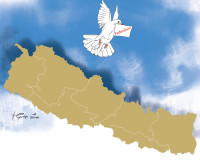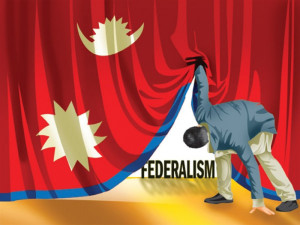Columns
Tracking fiscal transfers
Provinces seem committed to local fund transfers, but there is room for improvement.
Khim Lal Devkota
Article 60, Clause 3 of the Constitution of Nepal states that the government shall distribute equalisation grants to provincial and local levels based on their expenditure needs and revenue capacity. The constitution mandates the provision of equalisation grants unconditionally, as it does not include the phrase “as per the law” in this context.
However, Clause 4 of the same article states that provinces can distribute equalisation grants to local levels based on their expenditure needs and revenue capacity in accordance with the law. This means the constitution requires provinces to enact a law before distributing equalisation grants. In contrast, for the GoN, whether a law is enacted does not matter—the constitution obligates it to distribute equalisation grants to provinces and local levels.
Clause 6 of Article 60 states that the distribution of conditional grants, matching grants, or special grants provided by the government from the Federal Consolidated Fund shall be governed by federal law. But, a law must be enacted for the federal government to do so. The constitution envisions only four types of grants and does not provide for additional categories.
The National Natural Resources and Fiscal Commission Act, 2017, outlines the basis for the equalisation grant distributed by the government and the provinces. The Intergovernmental Fiscal Arrangement Act, 2017, retains the constitutional provisions, but the Commission’s Act explicitly mentions the basis for equalisation grant distribution. The Intergovernmental Fiscal Arrangement Act also includes provisions regarding the criteria for conditional, matching and special grants that the government provides. Additionally, it states that, in the case of provinces, such grants shall be governed by provincial law.
Article 251 of the constitution specifies that the basis for the equalisation and conditional grants distributed by the government to provinces and local levels shall be determined based on recommendations from the National Natural Resources and Fiscal Commission. However, the constitution states that grants from provinces to local levels shall be governed by provincial laws, meaning provinces are not required to follow the Commission’s recommendations.
Although this is not explicitly mentioned in the constitution, federal laws such as the Fiscal Commission Act and the Intergovernmental Fiscal Arrangement Act have incorporated matters related to provincial jurisdiction. While this may not fully align with the constitution, it has been the practice. Practices implemented with good intentions should be followed. In addition to the equalisation grant, the government also provides conditional, matching and special grants to provinces and local levels.
The formal implementation of the constitution began with the three-tier elections in 2017. The first federal budget was introduced in FY 2018-19, initiating the process of distributing all four types of grants. According to the budget speech booklet for FY 2018-19, provinces received a total grant of Rs123 billion, of which 40.75 percent were equalisation grants, 51.75 percent was conditional grants, and the remaining 8.10 percent comprised matching and special grants. Likewise, the government allocated Rs205 billion in grants to local levels, of which 41.38 percent were equalisation grants and 53.74 percent were conditional grants, with the remaining portion allocated as matching and special grants.
In terms of the overall budget, provinces received 9.39 percent of the national budget as grants in FY 2018-19, while local levels received 15.57 percent. When considering only equalisation grants, provinces received 3.83 percent of the total national budget, whereas local levels received 6.44 percent.
Similar to the federal budget, provinces also introduced their first full-fledged budgets in FY 2018-19. That year, all provinces enacted laws to distribute grants to local levels. The total provincial budget in FY 2018-19 was Rs208 billion, of which Rs11.75 billion (5.64 percent) was allocated as grants to local levels. In the second full-fledged budget for FY 2019-20, the total budget of all seven provinces was Rs259.57 billion, with Rs26.04 billion (10.17 percent) allocated to local levels. In FY 2019-20, provinces received Rs110 billion from the government, accounting for 7.17 percent of the national budget.
Notably, the share of grants that provinces distributed to local levels (10.17 percent) was higher than the share they received from the GoN (7.17 percent). Although provinces have smaller budgets, their higher proportion of grant distribution to local levels is a positive aspect.
In FY 2023-24, provinces allocated 9.3 percent of their total budgets to local levels, while in FY 2024-25, they proposed allocating 10.44 percent. In the national budget for FY 2024-25, the share of grants allocated to provinces is 5.18 percent. However, provinces have proposed allocating a higher proportion of their budgets to local levels compared to what they receive from the government. In the Koshi Province budget for FY 2024-25, 67.50 percent of total grants consist of equalisation and conditional grants, while 32.50 percent are matching and special grants.
In the government’s budget for FY 2024-25, the percentage allocated for equalisation grants to provinces is 3.23 percent, while the percentage of grants from provinces to local levels is 2.73 percent. This suggests that provinces need to improve in this area.
In FY 2024-25, the proposed total grant allocation from the government to provinces is Rs96 billion, of which 11 percent consists of matching and special grants. However, in the proposed total grants from provinces to local levels, matching and special grants account for 33.49 percent. This indicates that provinces have placed relatively more emphasis on matching and special grants.
Provinces have shown a commitment to transferring funds to local levels. They have increased grants to local levels, often exceeding their own receipts from the federal government. But there is room for improvement. The distribution remains imbalanced, with equalisation grants—meant to reduce fiscal disparities—receiving less priority than conditional and special grants.
To strengthen federalism, provinces must ensure a fairer allocation of equalisation grants while maintaining strategic conditional support. Transparency in allocation criteria, adherence to constitutional mandates, and improved monitoring are essential for bridging local development gaps. Federal and provincial governments must collaborate to refine legal frameworks, enhance revenue capacities and align transfers with actual needs rather than political interests. A well-structured fiscal transfer system will empower local levels, promote equitable development and strengthen federalism—ensuring inclusive, efficient and responsive governance.




 12.12°C Kathmandu
12.12°C Kathmandu
.jpg&w=200&height=120)












%20(1).jpg&w=300&height=200)

